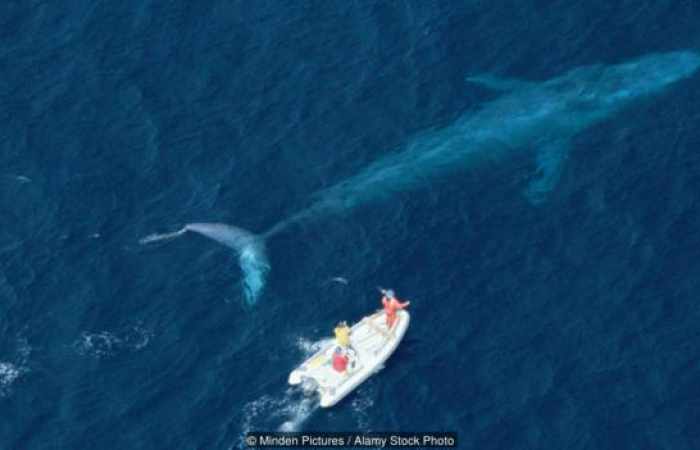These mysterious, super-sized bodies of water have challenged and pushed us to the limits of endurance and skill. They are the source for many impressive natural record breakers, and extraordinary human record-breaking achievements.
Largest animal ever

Contrary to its enormous size blue whales eat tiny shrimp-like creature called krill (credit: Minden Pictures / Alamy Stock Photo)
Ocean record breakers don’t get much bigger than this. The blue whale is the largest animal known to have existed, even bigger than the mightiest of dinosaurs. They have been known to weigh close to 200,000kg (31,494st) and reach lengths of over 30m (98.5ft). To put this into perspective, this wondrous mammal is about the length of three double decker buses.
With such gigantic proportions you’d expect some other record-breaking achievements and, again, the blue whale doesn’t disappoint. When one, which had sadly died, was recently washed ashore in Newfoundland, Canada, the heart was found to weigh 180kg (28st 4lb), making it the world’s biggest known heart. The aorta (the main artery that carries blood away from the heart to the rest of the body) was big enough to fit a human head. By comparison, an ant could crawl through a human aorta.
Biggest wave

Hawaiian surfer Garrett McNamara holds the record for the largest wave ever surfed (credit: Tó Mane)
Waves are created by tides and wind blowing over the surface of water, the size being determined by how long the wind has been blowing, its strength, and how far the wave has travelled. At 19m (62.3ft) the highest-ever wave detected by a buoy has been recorded In the North Atlantic Ocean. Even this monster is not the highest ever observed wave, which was 29m (95ft) and spotted by a ship in 2002, also in the North Atlantic.
For those interested in wave height, it is measured from the crest of one wave to the trough of the next. The wave surfing record currently stands at 23.77m (78ft) by Hawaiian surfer Garrett McNamara at Nazaré in Portugal in 2011. He may even have surfed a 30m (100ft) wave in the same region, an incredible feat that may soon be officially recognised. There are very few places in the world with monster waves for surfing, as underwater features, such as the arrow-shaped canyon at Nazaré, are important factors in creating the perfect conditions.
Longest migration by a mammal

The gray whale’s record-breaking migration lasted 172 days (credit: Mark Carwardine / naturepl.com)
The great wildebeest migration over the plains of Africa is impressive, covering almost 3,000km (1,800m). And the caribou of North America can travel up to 5,000km (3100 miles) per year. But both of these seem like a 'stroll in the park’ for the gray whale, which researchers recently discovered made a round trip of 22,500km (14,000 miles) as they travel from the east coast of Russia to breeding grounds off Mexico and then back again. It knocked the humpback whale's migration journey of 10,000km (6200 miles) from Brazil to Madagascar off the top spot.

British endurance swimmer Lewis Pugh is the world record holder for the most southerly swim (credit: Kelvin Trautman)
Some of the waters these whales traverse are very cold – too cold for most humans – but not for renowned endurance swimmer, Lewis Pugh, who set the world record for most southerly swim. He swam 350m (1,150ft) in the Bay of Whales in Antarctica’s Ross Sea, where the water temperature was -1C (30F) and air temperature of -37C (-34.5F). A feat all the more remarkable because he did it in only a pair of trunks, cap and googles.
Oldest living animals (vertebrate and invertebrate)

The Greenland shark recently replaced the bowhead whale as longest-lived vertebrate (credit: Franco Banfi / naturepl.com)
Vertebrates like us have a spinal cord surrounded by cartilage or bone and include mammals, birds, fish, amphibians and reptiles. And the longest-lived of them all can be found in the depths of the North Atlantic and Arctic Oceans: the Greenland shark. Last year a female was determined to be around 400 years old, although radiocarbon dating put her age between a ‘young’ 272 years and a respectably ‘old’ 512 years old. This means she was born between the early 1500s and mid-1700s. Even at the lower end of the range it still beats the former record-holder, a bowhead whale that was an estimated 211 years old.

Quahog clams are not only long-lived molluscs, their shells grow to heights in excess of 50mm (credit: Frank Hecker / Alamy Stock Photo)
Her age was most likely in the middle of the range, which means she was still a few years off becoming the most aged animal. That record belongs to an invertebrate called Ming, so called after the ruling dynasty of China during which it was born, a quahog deep-sea clam from the coast of Iceland. Recently its age had been increased from 405 years old to an impressive, and yet unbeaten, 507 years old.
We still have a way to go to beat these records. At 122 years, Jeanne Louise Calment is the oldest any human has lived – she was born in France in 1875. But the record for our longevity could be pushed beyond this, as Mbah Gotho from Indonesia claims to be 146 years old, although this remains unverified.
Fastest swimmers

Sailfish get their name from the distinctive dorsal fin (credit: Doug Perrine / naturepl.com)
How fast can you swim? Probably not as fast as Olympic swimmers such as Michael Phelps, who swims at around 8km per hour (5mph), but even these guys can’t get anywhere near the speeds to match a sailfish. It has been widely reported that sailfish can reach short bursts of speeds of about 110km per hour (68mph), as measured when leaping. But recent research suggests it’s more likely to be around a maximum of 40km per hour (25mph).
That’s still fast, but there may be another contender for the title of fastest fish: the black marlin. This mighty fish could potentially have been recorded accelerating at 129km per hour (80mph). It’s very difficult to accurately record and measure these speeds, but both fish are in the race for fastest swimmers on the planet.
Planet’s deepest point

Film director James Cameron piloted a submersible to the deepest known point on Earth at Challenger Deep (credit: Imeh Akpanudosen / gettyimages)
In the Pacific Ocean, east of the Philippines, lies the Mariana Trench. It’s a valley in the ocean floor formed when one tectonic plate moves beneath another one, and is more than 2,550km (1,500 miles) long and 69km (43 miles) wide on average. But it is its depth that makes it is truly outstanding, because not only is it the deepest part of the Earth's oceans, it holds the record for the deepest known point on Earth's surface. The distance between the trench’s deepest point at Challenger Deep and the the surface of the ocean is almost 11,000m (36,000ft).
You could drop Mount Everest into the Mariana Trench and its peak would still be over 1.6km (one mile) underwater, and where thousands of people have climbed Everest, only a very few have plunged the trench’s depths. One of whom was film director, James Cameron, in a deep-diving submersible called Deepsea Challenger during an expedition in 2012.
Deepest diving mammal

Cuvier's beaked whale holds two mammalian records: deepest dive and staying underwater without taking a breath (credit: Todd Pusser / naturepl.com)
When it comes to really deep-diving, Cuvier's beaked whales lead the pack, setting the world record for deepest diving mammal. Scientists recently tracked these whales and reported one having dived to depths of 2,992m (9,816ft). Setting a second mammalian record in the process, that of staying underwater without taking a breath for more than 2 hours at 138 minutes.

Austrian Herbert Nitsch has the nickname of ‘deepest man on earth’ (credit: sharky / Alamy Stock Photo)
There are a number of different human freediving records (diving without oxygen tanks and the diver relying on holding their breath), depending on the use of weights, fins and ropes. The deepest human free dives go down a few hundred metres, and when Herbert Nitsch first set the no limits category record at 214m (702ft), the Austrian earned the nickname of ‘deepest man on earth’.

World record holding freediver William Trubridge from New Zealand was the first to break the 100m barrier unassisted (credit: Nature Picture Library / Alamy Stock Photo)
William Trubridge is a 15-time world record holder and a multiple freediving world champion. He holds both the constant weight without fins record at 102m (334ft) and the free immersion record at 124m (407ft).
/BBC/
















































